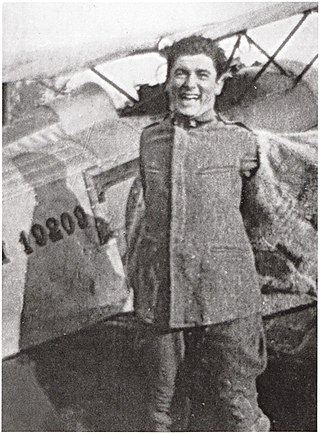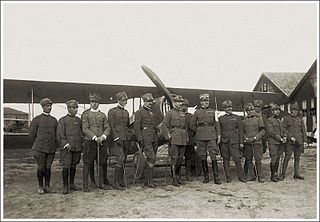Related Research Articles

The Italian Corpo Aeronautico Militare was formed as part of the Regio Esercito on 7 January 1915, incorporating the Aviators Flights Battalion (airplanes), the Specialists Battalion (airships) and the Ballonists Battalion. Prior to World War I, Italy had pioneered military aviation in the Italo-Turkish War during 1911–1912. Its army also contained one of the world's foremost theorists about the future of military aviation, Giulio Douhet; Douhet also had a practical side, as he was largely responsible for the development of Italy's Caproni bombers starting in 1913. Italy also had the advantage of a delayed entry into World War I, not starting the fight until 24 May 1915, but took no advantage of it so far as aviation was concerned.

Sottotenente Michele Allasia was a World War I fighter ace credited with five aerial victories.

Maggiore Sebastiano Bedendo was a World War I flying ace credited with five aerial victories. After completing his education postwar, he rejoined Italian military aviation. He set several world aviation flying records with a Nuvoli N.5 monoplane before dying in an air crash.
CapitanoGuido Masiero was a World War I flying ace credited with five confirmed and ten unconfirmed aerial victories. He was a prewar lancer who used his civilian engineering expertise to wrangle a transfer to aviation duty.

Amedeo Mecozzi was an Italian fighter ace of World War I, a general of the Italian Regia Aeronautica and a military theorist credited as the founding father of the "Attack air force" doctrine, which made him a strong opponent to general Giulio Douhet's theories.
Tenente ColonnelloGiorgio Michetti was a World War I flying ace credited with five aerial victories.

Sergente Maggiore Aldo Bocchese was a World War I flying ace credited with six aerial victories.
Sergente MaggioreAntonio Chiri was a World War I flying ace credited with six confirmed and seven unconfirmed aerial victories.

Sergente Cesare Magistrini began his lengthy aviation career as a World War I flying ace credited with six confirmed and four unconfirmed aerial victories.
Tenente Luigi Olivi (1894–1917) was an Italian World War I flying ace credited with six aerial victories. He won two awards of the Silver Medal for Military Valor and was killed in action.
Sergente Cosimo Rizzotto (1893–1963) was a World War I flying ace credited with six aerial victories.
Lieutenant Colonel Cosimo Rennella Barbatto (1890–1937) was an Ecuadorian World War I flying ace of Italian birth. He was credited with seven confirmed aerial victories flying for Italian aviation during the war; however, his pioneering civil aviation activities both before and immediately following the war were probably even more important than his martial career.
Tenente Gastone Novelli was a World War I flying ace credited with eight aerial victories.
TenenteCarlo Francesco Lombardi known as Francis was a World War I flying ace credited with eight aerial victories. Postwar, he was active in his family's rice refinery, as well as in record breaking flights. He formed the AVIA aviation company in 1938.

Tenente colonnelloAlvaro Leonardi was a World War I Sottotenente from Italy and a flying ace credited with eight aerial victories.
Capitano Antonio Reali was an Italian World War I flying ace credited with eleven confirmed aerial victories, and 22 unconfirmed victories. He served in the Regia Aeronautica Reserves from 1923 to about 1940.
Generale di Brigata AereaMarziale Cerutti began his military career in Field Artillery, but became a flying ace after his transfer to aviation service. He would be extensively decorated for valour, and credited with 17 confirmed aerial victories. He would also remain in Italy's aviation branch after World War I, becoming an officer of increasing importance. He rose through the ranks between the World Wars to become a Wing Commander with the rank of colonnello. During World War II, he served as Chief of Staff in Italy's North African Headquarters before being placed in command of Italy's air transport command. When Italy declared its armistice on 9 September 1943, Cerutti chose to continue service to Benito Mussolini. This resulted in his suspension from military duties at the end of World War II. He died in a motorcycle accident on 26 May 1946 while awaiting a final determination of his military status.
Flaminio Avet was a World War I flying ace credited with eight aerial victories. Although born in Nice, France, he served in the Italian military as Italy entered World War I. After a transfer from Lancers to aviation, he trained as a pilot. He began his aerial combat career on 27 November 1918, and would stake a dozen victory claims, eight of which would be verified. He ended the war having won the Silver Medal for Military Valor three times. He returned to Nice postwar, and died there on 21 August 1928.

LieutenantGiovanni 'Giannino' Ancillotto was an Italian World War I flying ace credited with 11 confirmed aerial victories. Rather unusually, he served solely with aviation while he was in the military, beginning in the lowest rank. Among his aerial victories as a fighter pilot were three over enemy observation balloons right after the Battle of Caporetto. As an example of the hazards of balloon busting, on 5 December 1917 Ancillotto returned to base with singed swatches of the third balloon's fabric adhering to his damaged fighter plane.
CapitanoErnesto Cabruna (1889–1960) was a professional soldier who became a World War I flying ace credited with eight aerial victories. He served in Italy's military police, beginning in 1907. After service in Libya and Rhodes, he received a Bronze Medal for Military Valor a year after Italy's involvement in World War I began. He turned to aviation, became a pilot, and as such earned his first Silver Medal for Military Valor at the end of 1917.